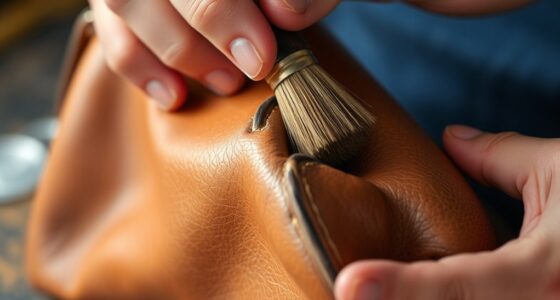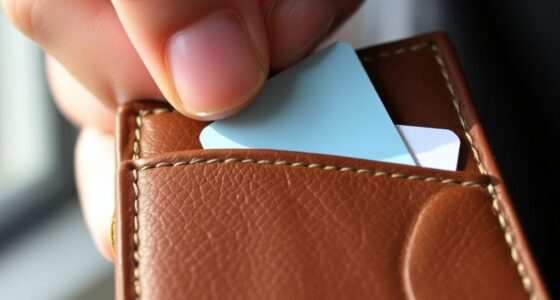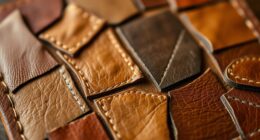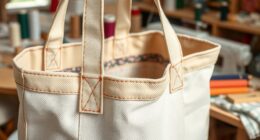To clean mold off vintage leather without damaging the finish, start by evaluating the mold’s extent and ensuring your workspace is well-ventilated with protective gear. Gently brush off surface mold with a soft brush or microfiber cloth, then wipe the leather with a damp, alcohol-dipped cloth to disinfect. Pat dry and avoid heat or sun. Applying a high-quality leather conditioner afterward helps restore suppleness. For detailed steps and tips, keep exploring how to protect your vintage pieces effectively.
Key Takeaways
- Gently remove surface mold using a soft microfiber cloth or brush without applying excessive pressure.
- Use a damp cloth with isopropyl alcohol sparingly to disinfect, avoiding soaking the leather.
- Air dry the leather thoroughly in a well-ventilated area, keeping it away from direct sunlight or heat sources.
- Apply a high-quality leather conditioner with gentle circular motions to restore moisture and protect the finish.
- Store leather in a cool, dry environment with breathable covers and humidity control to prevent future mold growth.
Assessing the Extent of Mold Damage

Before you begin cleaning, it’s important to evaluate how much mold has affected your vintage leather. Start by identifying the mold type—whether it’s surface mold or deeper-rooted growth—as this influences your cleaning approach. Examine the leather’s condition carefully; look for discoloration, cracking, or peeling, which indicate more severe damage. If the mold appears superficial and the leather remains supple, you can proceed with gentle cleaning methods. However, if the leather feels brittle or shows significant deterioration, you’ll need to be more cautious to avoid further damage. Evaluating the extent of mold damage helps you determine the best cleaning strategy and prevents unintentionally harming your vintage piece during the process. Additionally, understanding the extent of mold damage can guide you in selecting appropriate cleaning agents and techniques to protect the leather’s finish.
Preparing Your Workspace and Safety Equipment

Before you start cleaning, make certain your workspace is well-ventilated to avoid inhaling mold spores. Put on protective gear like gloves, masks, and eye protection to keep yourself safe. Proper preparation helps make the process safer and more effective. Using protective equipment such as goggles and respirators can prevent skin and eye irritation caused by mold spores.
Ventilate the Area
To effectively clean mold off vintage leather, you need to guarantee proper ventilation in your workspace. First, ventilate the area by opening windows and doors to increase airflow. This helps disperse mold spores and reduces the risk of inhaling harmful particles. Use fans to circulate air and ensure fresh air enters the space. Avoid working in enclosed, stagnant environments, as poor airflow can worsen mold issues and pose health risks. Proper ventilation also helps dry the leather faster after cleaning, preventing mold from returning. Additionally, controlling humidity levels is crucial, as air circulation directly affects moisture control and mold prevention. Keep the workspace well-ventilated throughout the process and after cleaning is complete. By ventilating the area, you create a safer environment and improve the effectiveness of your cleaning efforts.
Wear Protective Gear
Protecting yourself while cleaning mold off vintage leather is essential for safety. Wear gloves to prevent direct contact with mold spores, which can cause skin irritation or allergic reactions. Use a mask or respirator to avoid inhaling mold spores and airborne particles, especially if you’re working in a less-ventilated space. Safety goggles protect your eyes from splashes or airborne spores. Keep a clean workspace, free of clutter, and consider wearing a protective apron to prevent staining your clothes with cleaning agents or leather dye. Remember, mold spores can cling to surfaces and spread easily, so proper gear minimizes risk. Wearing the right safety equipment ensures you clean effectively without risking health or damaging the leather’s finish. Understanding city dynamics can help you identify safe and well-ventilated areas to work in while cleaning.
Gently Brushing Off Surface Mold
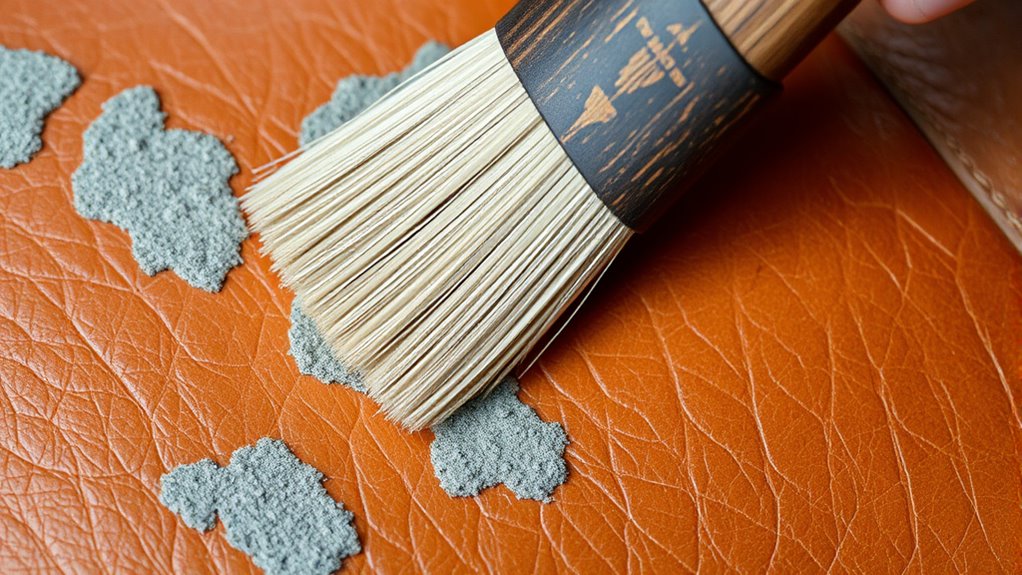
Gently brushing off surface mold is a crucial first step in cleaning vintage leather. Begin by inspecting the leather’s surface carefully to identify all affected areas. Use a soft-bristled brush or a microfiber cloth to remove loose mold and dust, focusing on dust removal without pressing too hard. This prevents damaging the leather’s finish and helps reveal any hidden mold spots. As you brush, keep your movements gentle and consistent to avoid scratching or scuffing the surface. Remember, the goal is to lift surface mold without forcing it deeper into the leather. Regular surface inspection during this process ensures you don’t miss any spots and helps you gauge whether additional cleaning steps are needed. This careful approach sets the foundation for safe, effective mold removal. Additionally, understanding the toilet maintenance and common issues associated with household plumbing can help prevent mold from spreading due to leaks or high humidity in storage areas.
Using a Mild Cleaning Solution Safely

Before applying any cleaning solution, make sure you choose a mild, leather-safe product to avoid damaging the vintage leather. Using a gentle cleaner supports leather preservation and helps prevent further mold growth. Look for products specifically formulated for leather, avoiding harsh chemicals that can strip the finish or weaken the material. Test the solution on a small, inconspicuous area first to ensure it doesn’t cause discoloration. When cleaning, use a soft cloth or sponge to apply the solution gently, working in circular motions. Avoid oversaturating the leather, as excess moisture can promote mold recurrence. Regular cleaning with a mild solution not only removes existing mold but also helps prevent future mold issues, ensuring your vintage leather remains in good condition for years to come. Additionally, understanding affairs and infidelity secrets can help recognize the importance of trust and honesty in maintaining healthy relationships, much like proper leather care preserves the integrity of vintage items.
Applying Isopropyl Alcohol for Mold Removal
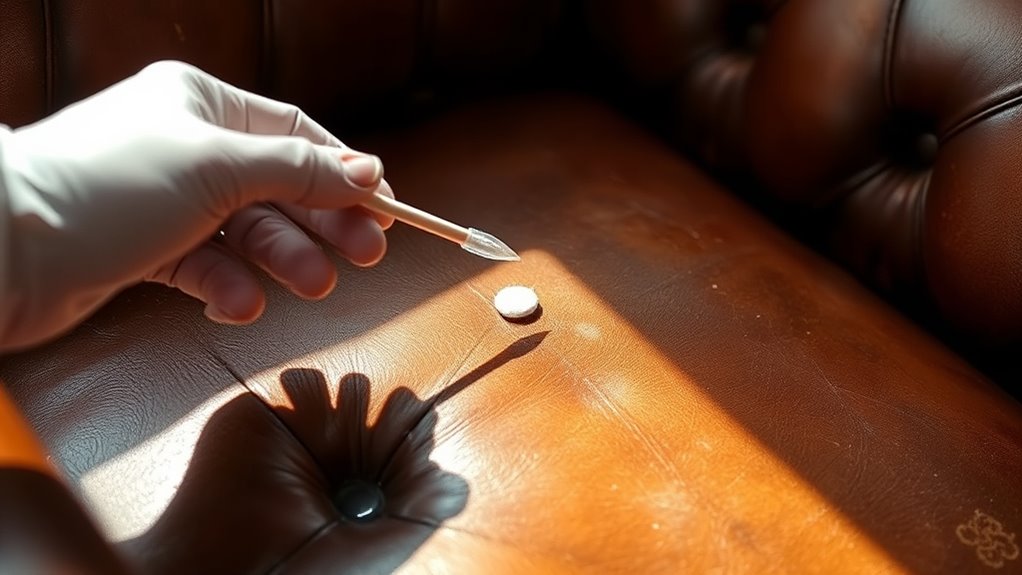
When applying isopropyl alcohol, it’s important to dilute it properly—mixing it with water in the right ratio guarantees effective mold removal without damaging your leather. Use a soft cloth or sponge to gently apply the solution, avoiding excessive rubbing that could harm the material. Always wear gloves and work in a well-ventilated area to keep safety a top priority. Additionally, understanding trust issues in relationships can help you recognize the importance of careful handling and patience during delicate cleaning processes.
Proper Alcohol Dilution Techniques
Applying isopropyl alcohol to remove mold from vintage leather requires proper dilution to guarantee effectiveness and prevent damage. You should pay close attention to the alcohol concentration, typically aiming for a 70% solution. To achieve this, use precise dilution techniques—mix one part isopropyl alcohol with one part distilled water. Avoid using higher concentrations, as they risk damaging the leather’s finish. Always measure carefully and mix thoroughly to ensure a consistent solution. Proper dilution not only maximizes mold removal but also minimizes the risk of drying or cracking the leather surface. Remember, the goal is to use enough alcohol to kill mold spores without harming the material, so adhere to recommended dilution ratios for safe, effective cleaning. Additionally, understanding the environmental impact of cleaning agents helps in choosing safer solutions that protect both the leather and the surrounding ecosystem.
Gentle Application Methods
To effectively remove mold from vintage leather, you should use gentle application methods that minimize the risk of damage. Dampen a soft cloth with a diluted solution of isopropyl alcohol, avoiding oversaturation. Lightly wipe the affected area, ensuring you don’t scrub or apply excessive pressure, which could harm the leather’s finish. This gentle approach helps preserve the leather’s natural scent and prevents any discoloration. After cleaning, allow the leather to air dry thoroughly in a well-ventilated space. Consistent use of gentle methods not only removes mold effectively but also supports mold prevention in the future. Additionally, choosing a preppy style of leather care can help maintain a sophisticated appearance. Remember, patience and care are key to maintaining the integrity of your vintage leather while ensuring it stays fresh and mold-free.
Safety Precautions for Leather
Using isopropyl alcohol to remove mold from vintage leather requires careful attention to safety precautions. Always work in a well-ventilated area to avoid inhaling fumes, and wear gloves to protect your skin. Test a small, hidden area first to confirm the alcohol won’t damage the leather’s finish or color, especially if you plan to dye or recolor with leather dyeing products later. Avoid excessive use, as too much alcohol can dry out or weaken the leather. After cleaning, consider applying a mold resistant spray to prevent future growth. Keep the leather dry and store it in a cool, dry place. Being aware of the role of protective gear can further ensure safe handling during the cleaning process. Following these precautions helps preserve the leather’s integrity while safely removing mold.
Wiping and Drying the Leather Properly
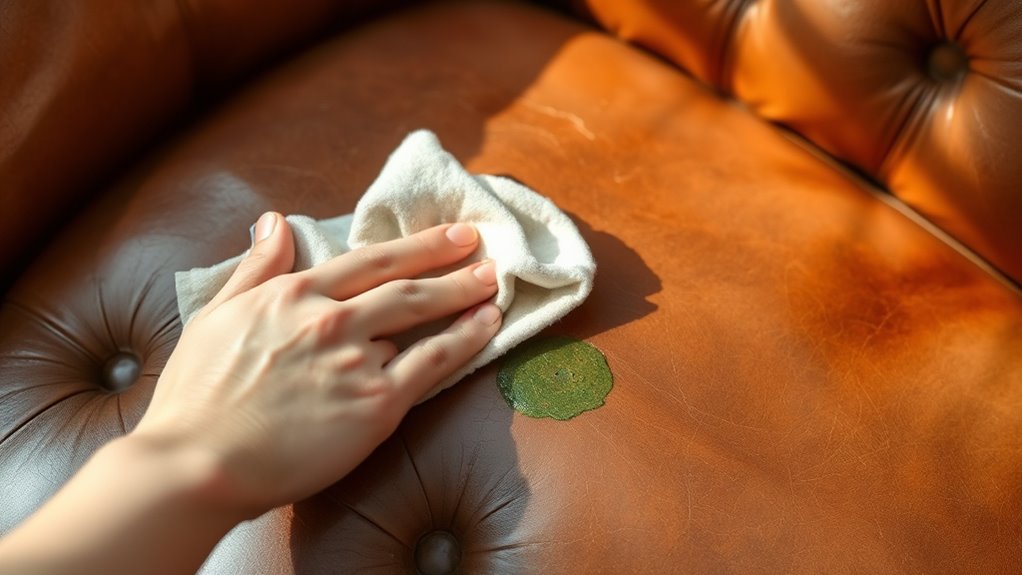
After you’ve wiped away the mold with a damp cloth, it’s vital to dry the leather thoroughly to prevent further damage. Proper drying is a key step in leather care and mold prevention. Use a soft, dry cloth to gently pat the surface, removing excess moisture. Avoid direct heat sources, which can crack or warp the leather. Allow the item to air dry in a well-ventilated area, away from sunlight. To help you understand the process, here’s a quick guide:
| Step | Tip |
|---|---|
| 1 | Pat with a dry cloth to absorb moisture |
| 2 | Air dry in a ventilated space |
| 3 | Keep away from direct sunlight |
This ensures your vintage leather stays in good shape after cleaning.
Conditioning the Leather After Cleaning
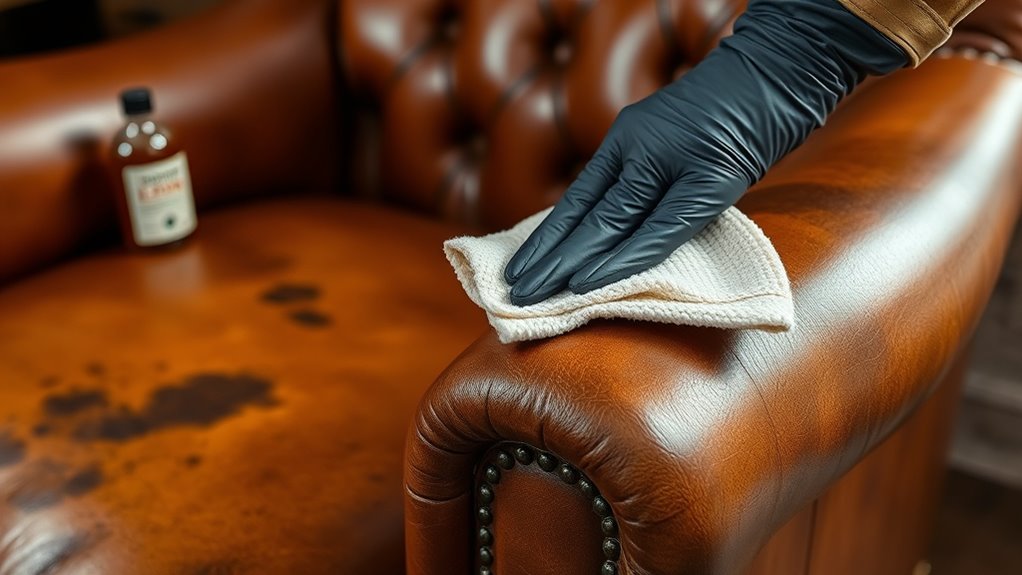
Once the leather is completely dry, conditioning helps restore its suppleness and forms a protective barrier against future mold growth. Apply a high-quality leather conditioner using a soft cloth, working it into the surface with gentle circular motions. This step not only revitalizes the leather’s natural oils but also helps prevent mold from taking hold again by maintaining proper moisture levels. Be sure to choose a conditioner suited for vintage leather to avoid any damage or discoloration. Regular conditioning after cleaning is essential for preserving the leather’s appearance and durability. Remember, a well-conditioned piece resists cracking and mold, extending its lifespan. With consistent care, your vintage leather will stay soft, resilient, and mold-free for years to come.
Preventative Measures to Avoid Future Mold Growth
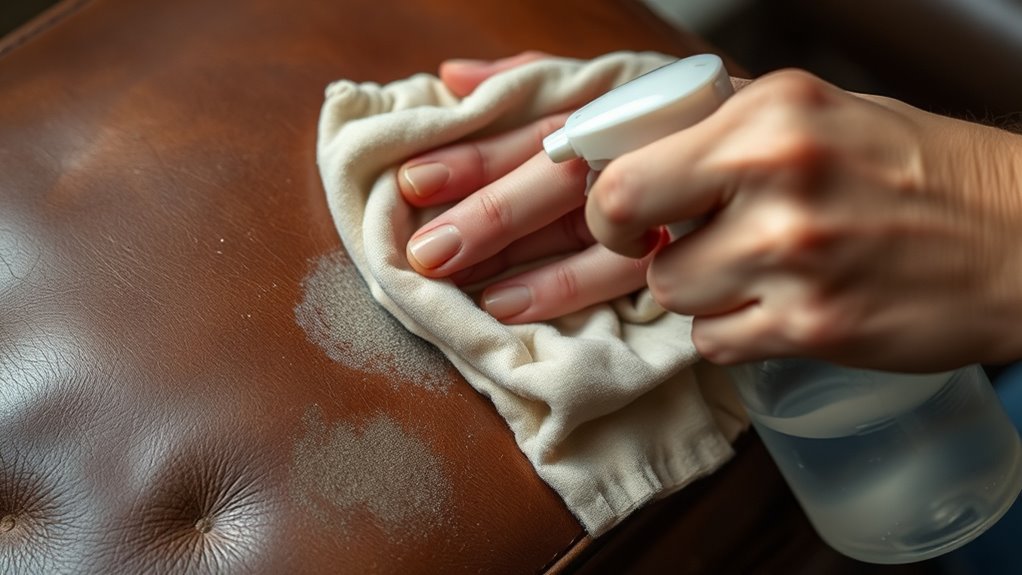
To prevent future mold growth on your vintage leather, it’s essential to control the environment where the leather is stored. Proper leather preservation involves maintaining a cool, dry space with stable humidity levels. Avoid damp areas and ensure good air circulation to reduce moisture buildup. Using silica gel packs or dehumidifiers can help keep the environment dry. Regularly inspect your leather items for early signs of mold or deterioration. Keep the storage area clean and free of dust, which can harbor mold spores. Additionally, consider treating your leather with a mold prevention spray designed for leather. These steps considerably reduce the risk of mold growth, ensuring your vintage leather remains in pristine condition for years to come.
- Maintain low humidity levels (ideally below 50%)
- Store in a well-ventilated space
- Use moisture absorbers like silica gel
- Regularly inspect and clean storage areas
- Apply mold prevention treatments specifically for leather
Storing Vintage Leather Items Safely
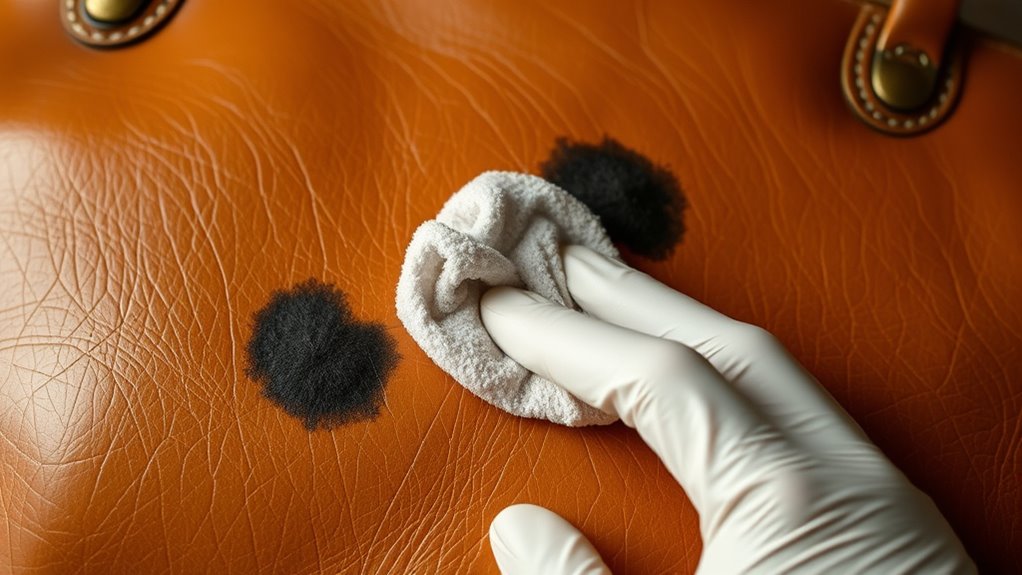
Proper storage is key to keeping your vintage leather items in top condition over time. To guarantee leather preservation, store your pieces in a cool, dry place away from direct sunlight, which can cause fading and drying. Use breathable covers like cotton bags or pillowcases instead of plastic, as plastic traps moisture and encourages mold growth. Maintain low humidity levels to prevent mold prevention issues. Avoid overcrowding your storage space, allowing air circulation around each item. Regularly check your stored leather for signs of moisture or mold, and clean as needed. Proper storage not only protects your leather’s finish but also prolongs its life, ensuring that your vintage pieces stay beautiful and mold-free for years to come.
Frequently Asked Questions
Can Mold Damage Affect the Leather’s Structural Integrity?
Mold damage can weaken the leather fiber if it penetrates deeply, potentially compromising the leather’s structural integrity. When mold penetrates the surface, it can cause the fibers to break down over time, making the leather more fragile and susceptible to tears. To prevent this, you should act quickly to clean and treat the affected leather, focusing on removing mold without damaging the finish, thereby preserving its strength and longevity.
Are There Specific Types of Leather More Resistant to Mold?
Think of leather as a fortress, with some walls stronger against invaders like mold. Certain leather types, such as full-grain or vegetable-tanned, naturally boast higher mold resistance due to their dense, untreated surfaces. These materials act like seasoned shields, better defending your vintage piece. Understanding leather types and their mold resistance helps you choose and care for items, ensuring your treasured possessions stay safe from moisture and mold attacks.
How Long Should I Wait Before Using the Cleaned Leather Items?
After cleaning your vintage leather, you should wait at least 24 to 48 hours before using it again. This drying time guarantees all moisture evaporates, preventing mold from returning. Store the leather in a well-ventilated space, avoiding direct sunlight, and use proper storage tips like using breathable covers. Patience during drying helps protect the finish and keeps your leather looking its best for years to come.
Is It Safe to Use Commercial Mold Removers on Vintage Leather?
Imagine delicate lace meeting tough steel—that’s the contrast when considering mold remover safety on vintage leather. Commercial mold removers aren’t designed for leather finishes; they can cause damage or discoloration. You should avoid using harsh chemicals, opting instead for gentle, leather-safe solutions. Always test on a hidden area first, ensuring your vintage leather’s finish stays intact. Preservation is key, so choose products specifically crafted for leather care.
Can Mold Spores Cause Health Problems During Cleaning?
When you’re cleaning mold, mold spore inhalation can cause health problems, especially if you’re sensitive or have mold allergy symptoms. Breathing in spores might trigger respiratory issues or worsen allergies. To stay safe, wear a mask and work in a well-ventilated area. Proper protective gear helps prevent inhaling spores, reducing health risks during cleaning. Always take precautions to protect your health when dealing with mold.
Conclusion
Once you’ve cleaned and conditioned your vintage leather, imagine it basking in gentle sunlight, its surface gleaming and free of mold. With proper care and storage, your treasured piece remains a timeless treasure, ready to withstand the test of time. Think of each step as a protective shield, guarding against future mold growth. Your careful attention transforms a delicate surface into a resilient, beautifully preserved heirloom, ready to tell its story for generations to come.


